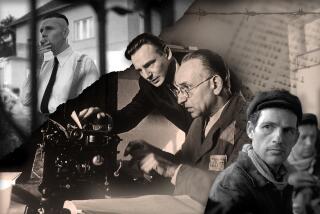The banality of the ‘banality of evil’
Adolf Eichmann is an icon of the 20th century and of the genocide the Nazis waged against the Jews. The image of the murderer sitting inside a bulletproof glass booth at his trial in Jerusalem in 1961 has come to encapsulate the
satisfying story of the perpetrator meeting justice at the hands of his victims. Eichmann today is the face of Nazi mass murder.
Yet Eichmann was not always among the pantheon of Nazi killers, and few have been so mythologized and misunderstood.
Although he was a colonel in the Nazi security service and chief of the Jewish Department, Bureau IVB4, of the SS head office, he scarcely figured at the Nuremberg Tribunal. Even though he was responsible for driving through the “Final Solution,” Eichmann was almost unknown. He had always operated in the background and covered his tracks well.
In the years immediately after the end of World War II, it was widely argued and generally believed that the Third Reich was created by a gang of pathologically inclined misfits who seized a modern state and bent it to their demented purposes. This top-down model informed the charges against the Nazi leadership. The worst crimes were blamed on the SS, whose members were characterized as fanatical robots or sadistic monsters.
Eichmann made only a perfunctory appearance in early histories of the Nazi persecution and mass murder of the Jews. As late as 1957, when Isser Harel, head of the Israeli secret service, received a tip about Eichmann’s hiding place in Argentina, he had little idea of his quarry’s significance.
But after the Mossad’s dramatic kidnapping of Eichmann from a Buenos Aires street in 1960 and the sensational criminal trial that followed -- beginning 45 years ago this month -- his obscurity came to an end. In the rush to satiate public curiosity, several journalists churned out biographies that cumulatively turned him into an iconic figure.
Much of their information came from a largely spurious prison statement by Dieter Wisliceny, one of Eichmann’s subordinates. Eichmann’s hasty biographers uncritically slotted this information into the early psychological explanations of fascism, especially the theories of Theodor Adorno, who had developed the model of the “authoritarian personality.” A 1960 pot-boiler by NBC correspondent John Donovan typified the genre. According to Donovan, Eichmann presented the “classic pattern of the disturbed, introverted personality which so often produced the larvae of fanaticism.” Eichmann “drifted around in a world without hope” until he “traded a threadbare suit for the splendid SA uniform.” This was nonsense. Eichmann’s interrogation and examination in court revealed a normal childhood. True, he lost his mother at a vulnerable age, but he got on with his stepmother. Although his father experienced economic vicissitudes during the 1920s, the family was never destitute. On the contrary, they were pillars of the bourgeoisie in Linz, Austria.
Eichmann did not excel at school, but he eventually found his metier as a sales representative for a petroleum company. After he was made redundant in May 1933 because of the economic downturn, his Jewish employers gave him generous severance pay.
Eichmann did not join the Nazi Party because he was down on his luck. He had been a member since April 1932, when he enrolled at the invitation of Ernst Kaltenbrunner, a party activist and family friend. Until then, Eichmann had associated with right-wing groups but regarded the Austrian Nazis as riffraff. Kaltenbrunner, however, was a respectable lawyer, and his approach flattered Eichmann.
It is a comforting illusion that Eichmann was an inveterate Jew-hater who entered the SS in order to pursue a racist vendetta. Although he doubtless shared the prejudices of his milieu, the truth is that when he transferred to the security service in 1934, it did not even have a brief to deal with Jews. He was later assigned to the service’s embryonic Jewish Department by chance. No one could have foreseen that five years later it would be the dynamo of Nazi anti-Jewish policy.
All this came out in the trial, but Gideon Hausner, Israel’s attorney general and the chief prosecutor, downplayed it; he wanted to transfigure Eichmann into the personification of evil. In defiance of the evidence accumulated by the police investigation, Hausner resolved to pin every crime against the Jews onto the man with the “Satanic personality.” Eichmann, Hausner said, was “a new kind of killer, the kind that exercises his bloody craft behind a desk.”
One foreign journalist saw through Hausner’s exaggerations. Hannah Arendt, who attended the first weeks of the trial, wrote that it was “bad history and cheap rhetoric.” Although she missed most of Eichmann’s testimony, she realized that his self-denigration was largely the truth. His authority was circumscribed geographically and limited by competing agencies. He was just a middle manager of genocide, only zealous insofar as he was obedient to a regime that had inverted morality and embodied inhumanity in the law.
However, Arendt merely succeeded in creating an alternative myth. She went to Jerusalem determined to find the embodiment of totalitarian man, an abstract figure she had conceived years earlier in “The Origins of Totalitarianism.” In this brilliant treatise, she argued that totalitarian regimes needed and created drones who unthinkingly obeyed orders and accepted the inversion of morality because authority so ordained.
Arendt’s depiction of Eichmann as a banal clerk gained scientific force thanks to Stanley Milgram’s research on obedience to authority. The first results of his contentious experiments -- in which he sought to find out what behavior people were capable of under the cover of “just following orders” -- were published in the same year as Arendt’s “Eichmann in Jerusalem.”
Both Arendt and Milgram were wrong. The Third Reich was anything but a smoothly operating totalitarian monolith in which impersonal bureaucrats mindlessly implemented orders handed down by authority figures. But their conjoined, eloquent polemics mesmerized a generation of historians and soothed a troubled public, seeming to offer a way of understanding the modern world, totalitarian systems and the threat of nuclear annihilation.
During the Cold War, Arendt’s theories provided both comfort and powerful propaganda for conservatives in the West by suggesting that there was no difference between the Third Reich and the Soviet system -- Eichmanns flourished under both. For the left, Arendt’s “banality of evil” model seemed to explain how government bureaucrats could operate weapons of mass destruction against civilians and how military men such as Army Lt. William Calley could follow orders and commit atrocities in Vietnam.
The chilling truth, however, is that Eichmann was not hard-wired to kill, nor was he psychopathically predisposed to become a perpetrator. He had a wide degree of latitude throughout his career and was constantly making choices. Nor can genocide and lesser atrocity be politically quarantined. Any political system that orders or permits mass atrocity will find the men and women to carry it out, not because they are atypical but because they are ordinary.
In our representations of Eichmann, there has always been a tension between the monstrous and the mundane. But as much as we may want Eichmann to be a psychotic individual and thus unlike us, he was not. He was neither insane nor was he a robotic receiver of orders. Eichmann was a normal man, and as long as there is a genocidal impulse, there will be Eichmanns.
More to Read
Sign up for Essential California
The most important California stories and recommendations in your inbox every morning.
You may occasionally receive promotional content from the Los Angeles Times.










